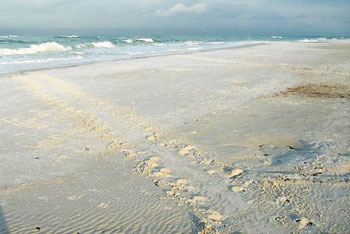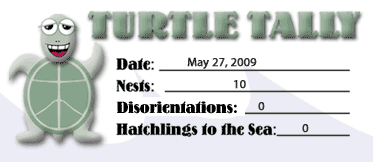Nesting season well under way

PHOTO COURTESY GEORGE BARFORD
Here, the clear signs that a loggerhead has come ashore
are
etched into the
morning beach profile.
Almost every night now, a turtle or two lumbers out of the water and onto a stretch of beach on Anna Maria Island.
On the Island, it’s almost exclusively loggerheads that nest. There has only been one other species that nested here. That was a green turtle that nested in 2001.
Sea turtles lay their eggs on their natal beaches, meaning the beaches on which they were born, according to scientists.
"That doesn’t mean they go back to that same grain of sand, but they do nest within a hundred miles or so from where they were born," Anna Maria Island Turtle Watch Director Suzi Fox said.
And since loggerheads take about thirty years to reach reproductive age, the turtles we are seeing come ashore during the 2009 nesting season were born here or within a hundred miles of here at least 30 years – and perhaps as much as 60 years ago.
Each female loggerhead will come ashore as many as three or four times during nesting season. She’ll only nest about once every three years, according to Fox.
"Nobody knows yet where the turtles are when they aren’t nesting, but scientists are keeping track of turtles by tagging them as they come ashore to nest," she said. "So we do know we are seeing the same turtle maybe three times in a season, and then we don’t see her again for another three years."
It’s Fox’s job to find the nests on the Island, to mark them off, keep them safe, keep statistics to forward to the state and make sure the hatchlings can get to the Gulf undisturbed and as close to what Mother Nature intended as possible.
To do that, she has recruited volunteers.
"I have the best volunteers in the world," she said. "They are all dedicated to saving sea turtles."
AMITW has divided the beach into nine sections, each about a mile long. A coordinator oversees each section.
Every morning at dawn, volunteers walk every single inch of the Island’s nesting beaches to search for signs that a turtle has nested.
"If they find a crawl, they call us and we come out to check," said Debbie Basillius, the coordinator for section seven. "We verify the nest, which means we dig down and ‘verify’ that there eggs in the nest. If there are, we stake the nest off to protect it."
The nest will be watched, and as the hatching date approaches, roughly 55 days after the egg was laid,the monitoring will be stepped up until the hatchlings can get safely and unmolested into the Gulf.
A few days later, the coordinators and volunteers dig up the nest to count the eggs. That way they know how many hatchlings made it out of the nest.
Only people listed on a special state permit are allowed to dig in the nests or touch eggs or hatchlings.
At the end of the year, data from our nests and from nests all over the state is forwarded to Tallahassee where it’s analyzed and collated. The Florida information becomes part of the national and international information that scientists are using as they learn understand our loggerheads and all species of sea turtle.
"We don’t have a chance of saving marine turtles, which are all threatened or endangered until we understand them," Fox said.



